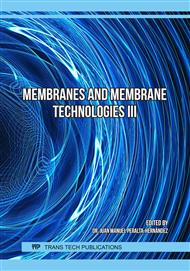[1]
K.N. Marsh, J.A. Boxall, R. Lichtenthaler, Room temperature ionic liquids and their mixtures - A review, in: Fluid Phase Equilib., Elsevier, 2004, p.93–98. https://doi.org/10.1016/j.fluid.2004.02.003.
DOI: 10.1016/j.fluid.2004.02.003
Google Scholar
[2]
J.P. Hallett, T. Welton, Room-temperature ionic liquids: Solvents for synthesis and catalysis. 2, Chem. Rev. 111 (2011) 3508–3576. https://doi.org/10.1021/cr1003248.
DOI: 10.1021/cr1003248
Google Scholar
[3]
A.I. Akhmetshina, N.R. Yanbikov, A.A. Atlaskin, M.M. Trubyanov, A. Mechergui, K. V. Otvagina, E.N. Razov, A.E. Mochalova, I. V. Vorotyntsev, Acidic gases separation from gas mixtures on the supported ionic liquid membranes providing the facilitated and solution-diffusion transport mechanisms, Membranes (Basel). 9 (2019) 1–14. https://doi.org/10.3390/membranes9010009.
DOI: 10.3390/membranes9010009
Google Scholar
[4]
J. Yuan, M. Antonietti, Poly(ionic liquid)s: Polymers expanding classical property profiles, Polymer (Guildf). 52 (2011) 1469–1482. https://doi.org/10.1016/j.polymer.2011.01.043.
DOI: 10.1016/j.polymer.2011.01.043
Google Scholar
[5]
I.M. Davletbaeva, G.R. Nurgaliyeva, A.I. Akhmetshina, R.S. Davletbaev, A.A. Atlaskin, T.S. Sazanova, S. V. Efimov, V. V. Klochkov, I. V. Vorotyntsev, Porous polyurethanes based on hyperbranched amino ethers of boric acid, RSC Adv. 6 (2016) 111109–111119. https://doi.org/10.1039/C6RA21638B.
DOI: 10.1039/c6ra21638b
Google Scholar
[6]
M. Li, L. Yang, S. Fang, S. Dong, Novel polymeric ionic liquid membranes as solid polymer electrolytes with high ionic conductivity at moderate temperature, J. Memb. Sci. 366 (2011) 245–250. https://doi.org/10.1016/j.memsci.2010.10.004.
DOI: 10.1016/j.memsci.2010.10.004
Google Scholar
[7]
A.L. Pont, R. Marcilla, I. De Meatza, H. Grande, D. Mecerreyes, Pyrrolidinium-based polymeric ionic liquids as mechanically and electrochemically stable polymer electrolytes, J. Power Sources. 188 (2009) 558–563. https://doi.org/10.1016/j.jpowsour.2008.11.115.
DOI: 10.1016/j.jpowsour.2008.11.115
Google Scholar
[8]
M. Li, S. Dong, S. Fang, L. Yang, S.I. Hirano, J. Hu, X. Huang, Polymeric ionic liquid membranes as electrolytes for lithium battery applications, J. Appl. Electrochem. 42 (2012) 851–856. https://doi.org/10.1007/s10800-012-0450-0.
DOI: 10.1007/s10800-012-0450-0
Google Scholar
[9]
R.L. Weber, Y. Ye, A.L. Schmitt, S.M. Banik, Y.A. Elabd, M.K. Mahanthappa, Effect of nanoscale morphology on the conductivity of polymerized ionic liquid block copolymers, Macromolecules. 44 (2011) 5727–5735. https://doi.org/10.1021/ma201067h.
DOI: 10.1021/ma201067h
Google Scholar
[10]
J. Yuan, D. Mecerreyes, M. Antonietti, Poly(ionic liquid)s: An update, Prog. Polym. Sci. 38 (2013) 1009–1036. https://doi.org/10.1016/j.progpolymsci.2013.04.002.
DOI: 10.1016/j.progpolymsci.2013.04.002
Google Scholar
[11]
J.E. Bara, E.S. Hatakeyama, D.L. Gin, R.D. Noble, Improving CO2 permeability in polymerized room-temperature ionic liquid gas separation membranes through the formation of a solid composite with a room-temperature ionic liquid, in: Polym. Adv. Technol., John Wiley & Sons, Ltd, 2008: p.1415–1420. https://doi.org/10.1002/pat.1209.
DOI: 10.1002/pat.1209
Google Scholar
[12]
J.E. Bara, R.D. Noble, D.L. Gin, Effect of free, cation substituent on gas separation performance of polymer-room-temperature ionic liquid composite membranes, Ind. Eng. Chem. Res. 48 (2009) 4607–4610. https://doi.org/10.1021/ie801897r.
DOI: 10.1021/ie801897r
Google Scholar
[13]
M. Li, L. Wang, B. Yang, T. Du, Y. Zhang, Facile preparation of polymer electrolytes based on the polymerized ionic liquid poly((4-vinylbenzyl)trimethylammonium bis(trifluoromethanesulfonylimide)) for lithium secondary batteries, Electrochim. Acta. 123 (2014) 296–302. https://doi.org/10.1016/j.electacta.2013.12.179.
DOI: 10.1016/j.electacta.2013.12.179
Google Scholar
[14]
A.L. Barbarini, D.A. Estenoz, D.M. Martino, Crosslinkable micelles from diblock amphiphilic copolymers based on vinylbenzyl thymine and vinylbenzyl triethylammonium chloride, J. Appl. Polym. Sci. 132 (2015) 1–10. https://doi.org/10.1002/app.41947.
DOI: 10.1002/app.41947
Google Scholar
[15]
O.V. Bashkov, A.A. Bryansky, I.V. Belova, D.B. Solovev, Investigation of the Stages of Damage Accumulation in Polymer Composite Materials, Materials Science Forum, Vol. 945 (2019) 515-521 [Online]. Available: https://doi.org/10.4028/www.scientific.net/MSF.945.515.
DOI: 10.4028/www.scientific.net/msf.945.515
Google Scholar



